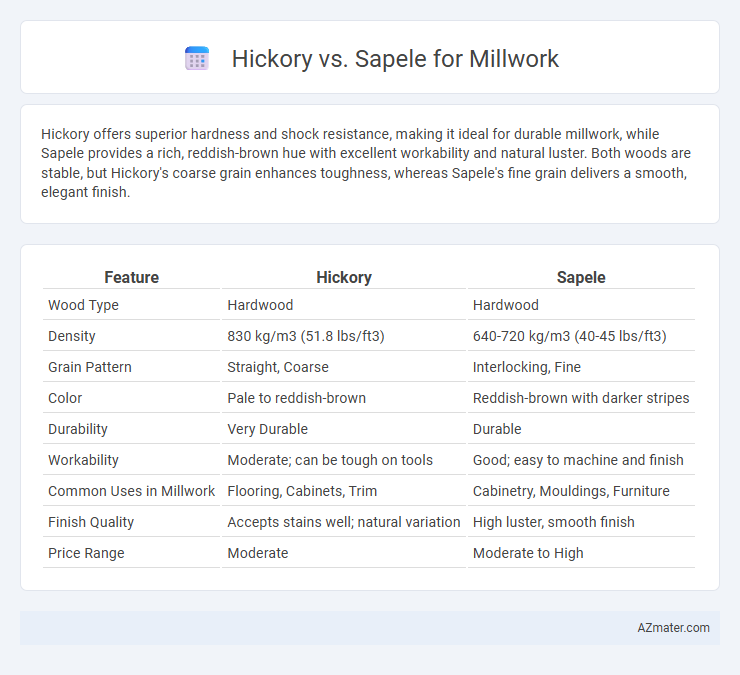Hickory offers superior hardness and shock resistance, making it ideal for durable millwork, while Sapele provides a rich, reddish-brown hue with excellent workability and natural luster. Both woods are stable, but Hickory's coarse grain enhances toughness, whereas Sapele's fine grain delivers a smooth, elegant finish.
Table of Comparison
| Feature | Hickory | Sapele |
|---|---|---|
| Wood Type | Hardwood | Hardwood |
| Density | 830 kg/m3 (51.8 lbs/ft3) | 640-720 kg/m3 (40-45 lbs/ft3) |
| Grain Pattern | Straight, Coarse | Interlocking, Fine |
| Color | Pale to reddish-brown | Reddish-brown with darker stripes |
| Durability | Very Durable | Durable |
| Workability | Moderate; can be tough on tools | Good; easy to machine and finish |
| Common Uses in Millwork | Flooring, Cabinets, Trim | Cabinetry, Mouldings, Furniture |
| Finish Quality | Accepts stains well; natural variation | High luster, smooth finish |
| Price Range | Moderate | Moderate to High |
Introduction to Hickory and Sapele for Millwork
Hickory offers exceptional hardness and durability, making it ideal for high-traffic millwork applications such as flooring, cabinetry, and trim. Sapele, a tropical hardwood with a distinctive interlocking grain, provides an elegant, reddish-brown finish often used in fine millwork, furniture, and decorative veneers. Both woods deliver unique aesthetic and structural qualities, with hickory emphasizing strength and sapele prized for its rich color and smooth texture.
Botanical Background and Origins
Hickory, belonging to the genus Carya, is native primarily to North America and is known for its dense, durable hardwood ideal for millwork applications requiring strength and wear resistance. Sapele, classified under the genus Entandrophragma, originates from tropical Africa and features a fine, interlocking grain that produces a smooth finish, making it popular for detailed millwork and cabinetry. Both woods offer unique botanical characteristics influencing their workability and aesthetic qualities in architectural woodwork.
Appearance: Color, Grain, and Texture
Hickory features a striking, varied color palette ranging from creamy white to rich reddish-brown, with pronounced grain patterns that exhibit a rugged, natural texture ideal for rustic or traditional millwork. Sapele boasts a refined appearance marked by its deep, reddish-brown hue and consistent interlocked grain, creating a smooth, shimmering texture known as a "ribbon stripe" effect that enhances contemporary and elegant millwork. Both woods offer unique aesthetic qualities, with Hickory providing bold contrast and texture, while Sapele delivers uniformity and subtle sheen.
Hardness and Durability Comparison
Hickory ranks higher on the Janka hardness scale, averaging around 1,820 lbf, which makes it one of the hardest domestic hardwoods ideal for millwork requiring maximum wear resistance. Sapele, with a Janka hardness of about 1,410 lbf, offers good hardness but falls short of Hickory's superior durability in high-traffic or impact-prone areas. The dense grain structure of Hickory contributes to its exceptional strength and longevity, while Sapele's moderate hardness and natural oils provide decent durability with enhanced resistance to moisture and insect damage.
Workability and Machining Ease
Hickory is highly favored for millwork due to its superior workability and excellent machining ease, allowing for smooth cuts, shaping, and finishing with minimal tool wear. Sapele, while visually appealing with its rich reddish-brown color and fine grain, poses more challenges in machining because of its interlocked grain and higher density, which can cause tear-out and require slower cutting speeds. Millwork projects demanding precision and efficiency often prefer Hickory for its consistent response to routers, saws, and sanders, ensuring clean edges and reduced production time.
Finishing and Staining Characteristics
Hickory offers a dense, coarse grain that absorbs stain unevenly, often resulting in a rustic, textured finish ideal for traditional millwork. Sapele features a fine, interlocking grain with natural luster, allowing for smooth, consistent stain application and a rich, uniform color suitable for elegant millwork pieces. While Hickory's finishing can highlight its natural ruggedness, Sapele's staining characteristics enhance its deep reddish-brown hues, making it preferred for high-end cabinetry and trim.
Cost and Availability of Hickory vs Sapele
Hickory is generally more affordable and widely available across North America, making it a cost-effective choice for millwork projects. Sapele, sourced primarily from West Africa, tends to be more expensive due to limited supply and higher import costs. The consistent availability of Hickory supports steady pricing, while Sapele's fluctuating supply can lead to price variability and longer lead times.
Suitability for Interior and Exterior Millwork
Hickory's dense grain structure and high hardness make it ideal for both interior millwork and exterior applications requiring durability against weathering. Sapele offers a smooth finish and natural resistance to moisture and decay, enhancing its suitability for decorative interior trim and exterior cladding. While Hickory excels in strength and impact resistance, Sapele stands out with its rich, reddish-brown color and stability in changing humidity conditions.
Sustainability and Environmental Impact
Hickory and Sapele both offer sustainable options for millwork, with Hickory being a fast-growing hardwood native to North America, which promotes responsible forestry practices and reduces transportation emissions. Sapele, harvested primarily from West African tropical forests, poses greater concerns due to deforestation and illegal logging, though certified sources like FSC can mitigate environmental impact. Choosing FSC-certified Hickory or Sapele ensures environmentally responsible sourcing, supporting biodiversity and sustainable forest management efforts.
Summary: Choosing the Right Wood for Your Millwork Project
Hickory offers exceptional durability and a striking grain pattern, making it ideal for millwork requiring strength and rustic aesthetics. Sapele provides a smooth texture with a rich, reddish-brown hue, perfect for elegant and refined millwork designs. Selecting between Hickory and Sapele depends on project needs for hardness, appearance, and color tone to achieve the desired balance of functionality and style.

Infographic: Hickory vs Sapele for Millwork
 azmater.com
azmater.com